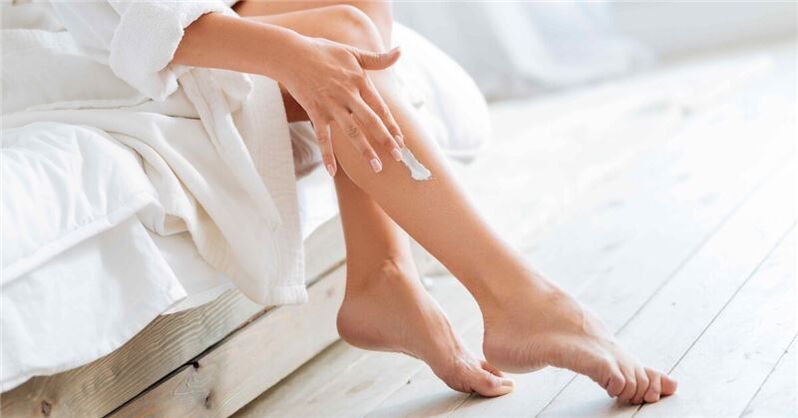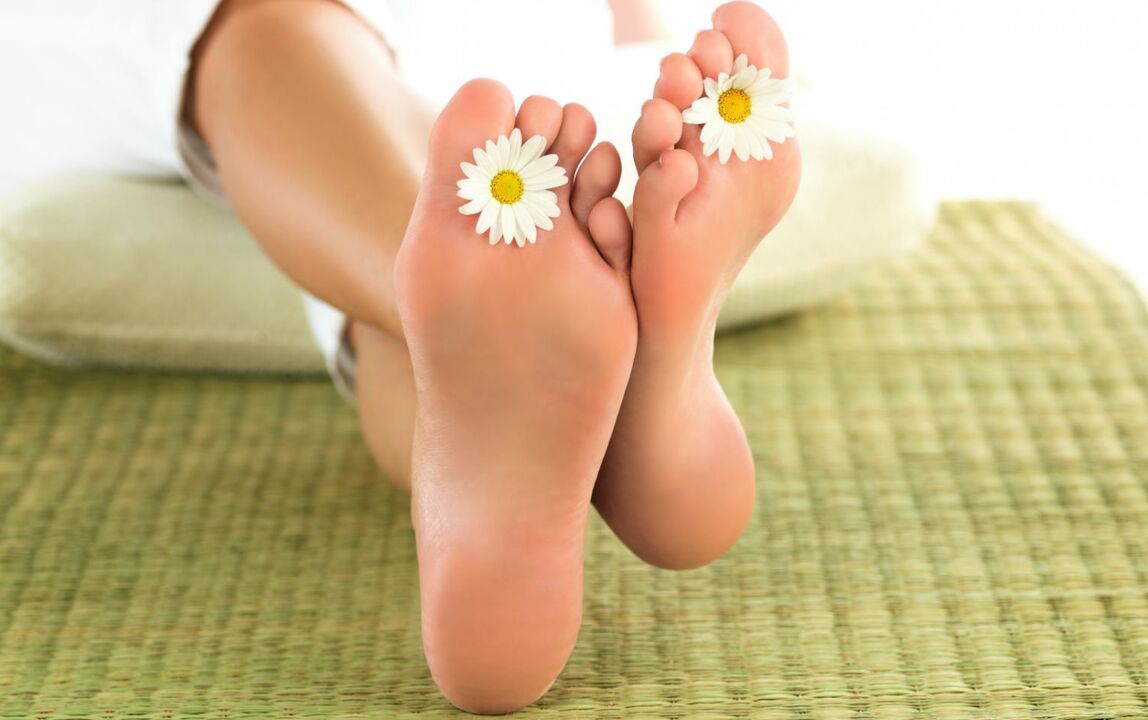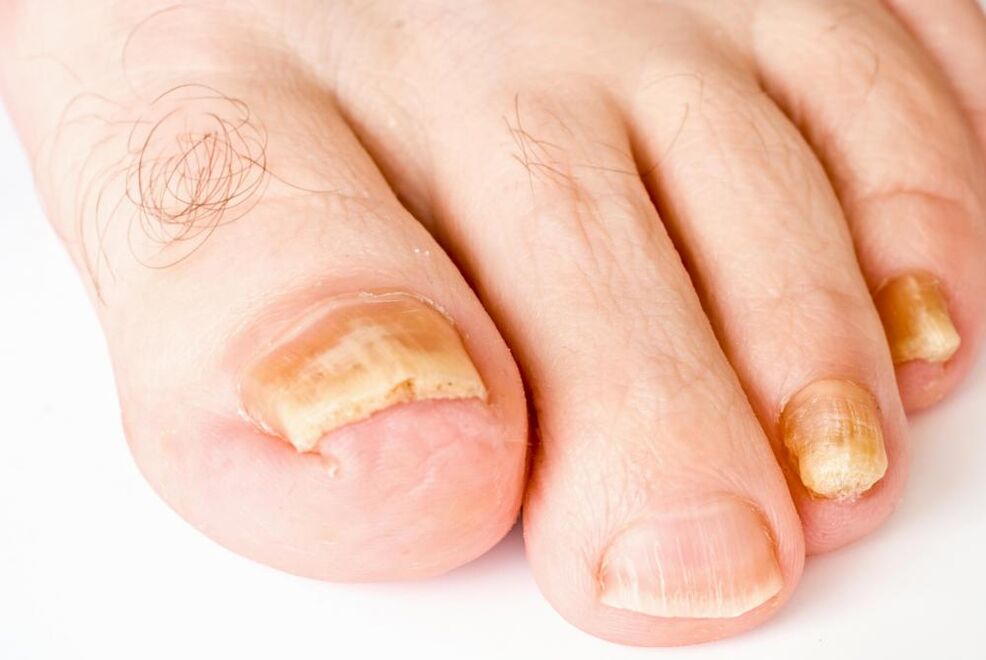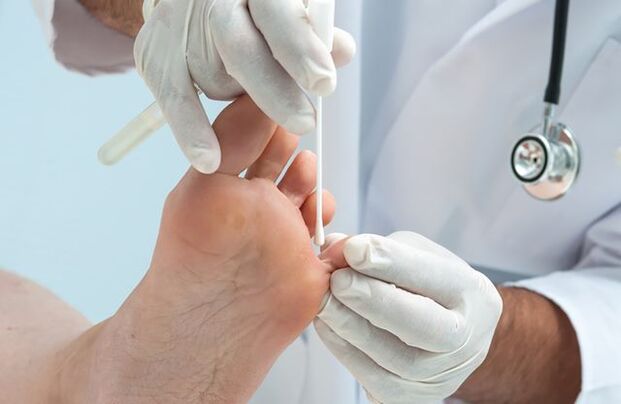Few people know that using vinegar can solve the rather complicated medical problem of getting rid of nail fungus. Thanks to the availability of table vinegar (9% acid solution) and even vinegar essence (70% acid solution) that can be purchased at a hardware store or market, there are many ways to treat foot fungus using this product.
Of course, self-treatment with vinegar should be carried out only if the disease has not passed into an advanced form, and it is recommended to combine it with specially developed drugs. However, when there is an urgent need to treat nail fungus and there is no money or time to visit a doctor or drug therapy, you can use vinegar yourself, the main thing is to adhere to the relevant safety rules.
Features of using vinegar to treat fungus

The main effect of using vinegar is to create an acidic environment in the area of the fungal infection, which prevents the growth of hyphae and the spread of spores. Gradually, the fungus, left without access to new sources of nutrients, dies, and the absence of much more durable spores prevents the possibility of a relapse of the disease.
At first glance, everything is very simple - how to destroy bacteria with an antiseptic. But in fact, the fungus is very persistent, since its body is not on the surface of the nail or skin, but penetrates deep into the tissue. In this regard, a positive result from the treatment of onychomycosis should be expected only with strict regularity of the procedures, which will not leave the parasite time for rehabilitation and penetration under the skin.
Before treating nail fungus, make sure that the concentration of acetic acid used corresponds to that indicated in the recipe. If the recipe mentions vinegar essence, it means a 70% solution to be dissolved or applied spot on. Food or table vinegar respectively contain 6 and 9% acid. Ignoring these data may result in the completion of chemical burn treatment.
Apart from this point, there are no special contraindications for vinegar treatment. Individual intolerance is very rare, but vinegar is such a common substance that patients are usually aware of this feature of the body. A burning sensation may occur during the first treatments, but this is normal and will subside with time. Otherwise, vinegar, if the safety rules are followed, does not pose a threat to health.
Vinegar baths
Warm foot baths are considered an effective remedy against fungi, regular use allows you to get rid of onychomycosis at an early stage without additional drugs. Also, vinegar baths are an excellent prevention of fungal infections. The procedure requires warm, about 50 ° C, water and a glass of table vinegar with a concentration of 9%. The water level in the basin should not be high, but only up to the ankles. The feet are immersed in the solution and kept there for 15 minutes.
Before the vinegar bath, it is recommended to perform a full pedicure, including the removal of the affected areas of the nail plate and dead skin layers, calluses and calluses on the feet, but without applying a decorative coating to the nails. If you trim and file your nails yourself, you should do it very carefully, as micro-damage to the skin can contribute to the spread of a fungal infection.
Immediately after the vinegar bath, wipe your feet with a towel and put on cotton socks. Repeat three times a week.
Lotions with vinegar
It is best to apply lotions to the areas affected by the fungus after vinegar baths. Both pharmaceutical products and pure 9% vinegar are suitable for this, in which a cotton swab is moistened and applied to the nail for fifteen minutes.
A more complex recipe: a mixture of vodka or forty proof medical alcohol, glycerin and acetic acid 70% in equal proportions, mix until smooth. A cotton swab moistened with the solution is kept on the affected areas for fifteen minutes, after which cotton socks are put on. The course of treatment is a week, if necessary, it can be repeated after a few days.
Vinegar-based ointments are stored for a long time, they are more convenient to use than products with a liquid consistency. To prepare vinegar ointment, you need to take 70% acetic acid, dimethyl phthalate, glycerin and olive oil in a ratio of 2: 1: 1: 1, respectively. After thoroughly mixing all the ingredients, the ointment is ready for use.
To prevent the spread of a fungal infection and destroy its pathogens, you should apply the ointment daily to the affected areas with a cotton swab, leave for 8-10 hours and then wash with laundry soap. This recipe can be used not only to treat onychomycosis of the toenails, but also on the affected fingernails.
Preventive measures against fungi consist in observing hygiene rules, especially in public places - bathroom, swimming pool, bowling club. Choose comfortable shoes and socks made of natural materials, because poor blood circulation in the feet, combined with high humidity, create prerequisites for the development of onychomycosis (read also: onychomycosis - causes and prevention). Gymnastic exercises, moderate physical activity and running improve blood circulation and strengthen the immune defense, which makes the body invulnerable to fungal and other infections.
Nail fungus treatment with tea tree oil
Tea tree oil is an effective remedy against onychomycosis, acting directly on the causative agent of the disease - dermatophyte fungi. Tea tree essential oil contains alpha-terpinene, alpha-phellandrene, limonene, sabinene, cineole and other substances that provide its antiseptic properties and anti-inflammatory effect.
Before using essential oil, it is necessary to do an allergy test - apply a little product to the skin of the wrist, if within 12 hours there is no irritation, redness of rashes or other reactions, then the product can be used for medical purposes. Otherwise, it must be diluted to a safe concentration or this technique must be abandoned altogether.
Ways to use tea tree oil:
Foot baths with tea tree oil. Warm water is poured into a basin up to the level of the ankles, 15-20 drops of essential oil are added and the feet are kept in it for twenty minutes, maintaining a high water temperature (45-50 °C). The course of treatment is two months, baths should be taken daily. During the treatment procedure, it is necessary to remove the affected areas of the nail plate using a file, nail clippers or scissors.
Applying oil to the nail plate. If you do not have a reaction to undiluted tea tree oil, then to improve the effectiveness of the effect, it is applied in its pure form to the affected areas of the nail. First, the feet are steamed in warm water with the addition of laundry soap (for better dissolution, it can be grated). The oil is rubbed into the nail plate with a cotton swab twice a day, it is not necessary to rinse the product.
How to quickly cure toenail fungus?

The internal and external use of hydrogen peroxide for the treatment of infectious and other diseases is described by Professor Neumivakin in a book written on the basis of personal experience. He mentions hydrogen peroxide as a preventative with antibacterial properties.
The external use of hydrogen peroxide for the treatment of fungal infections is carried out after steaming the feet in warm water with dissolved soda in the amount of one teaspoon per liter. When the nail plates become soft, pinch off a small fragment of the affected area of the nail with nail scissors and, after soaking it in a 3% peroxide solution, apply it to the nail plate. Leave on for 10-15 minutes on fingernails or 40 minutes to an hour on toes. Do the procedure twice a day until the symptoms of the fungal infection disappear.
To reduce the evaporation of the peroxide and increase the intensity of the effect, the nail plate with the lotion is wrapped in a plastic film. After the exposure time has elapsed, rinse your toes and hands thoroughly under running water.
For therapeutic and prophylactic purposes, it is recommended to infuse the nail cavity with hydrogen peroxide three times a day.
Hand and foot baths (depending on the localization of onychomycosis) with hydrogen peroxide give good results. Dilute 3% hydrogen peroxide in water at a temperature of 40-50 ° C in the amount of two tablespoons per liter of water. The duration of the procedure is fifteen minutes, the frequency is twice a day for one week.
Instead of hydrogen peroxide in this recipe, you can use dead water with a negative redox potential, also called anolyte water. Anolyte water is safe to use on sensitive skin, but has antiseptic properties that reduce fungal growth.
Effective treatment of advanced toenail fungus
This extreme method of treating fungal infections is used for severe lesions of the nail plate, it should be used with caution so as not to damage the skin.
To get rid of the fungus, the nail is treated with a rust neutralizer (this can be purchased at an auto parts store). This product contains phosphoric acid, which effectively kills fungus, but if used carelessly, it can damage skin tissue. Therefore, when using it, it is necessary to observe safety measures - work in a well-ventilated room, wear safety glasses and rubber gloves, avoiding contact of the product with the skin and mucous membranes.
A safer way would be to use kerosene, which also has a high penetrating power and a very strong effect on fungi.
Other folk remedies for the treatment of nail fungus
Complex treatment of toenail fungus using folk recipes based on hydrogen peroxide allows you to destroy the fungus and get rid of the unpleasant smell and other accompanying symptoms forever.
Two effective folk remedies against fungal infections:
Recipe for peroxide 1. To prepare the healing mixture, you will need baking soda (0. 5 cup), hot water (4 cups), 3% hydrogen peroxide (0. 25 cup) and half a cup of magnesium sulfate or Epsom salt. Mix all the ingredients well and pour another quarter cup of vinegar. Soak a cotton pad with the resulting solution and attach it to the nail plate affected by the fungus with the help of a plaster. The bandage must be renewed every ten hours, the course of treatment is a month.
Recipe with peroxide 2. The procedure for treating fungus according to this recipe consists of three stages. First, you need to prepare a solution for treating nail and skin surfaces affected by fungus - mix 3% vinegar and peroxide at a concentration of 3% in a 1: 1 ratio. This mixture is applied to the feet until it sizzles. The second stage is to soak the fingers with a fungal infection of the nails for half a minute in a weak solution of bleach in water, then wash them thoroughly under running water and wipe them with a towel. Finally, tea tree oil mixed with vaseline in equal proportions is applied to the nail plate. Wear warm socks or gloves (if this technique was used to treat nail onychomycosis). The course of treatment is a week.
Novocaine lotion. A very simple but effective folk remedy for the treatment of fungus is novocaine lotion. Simply soak a piece of cotton wool with novocaine and apply it to the fungus overnight. Just two of these lotions are enough to get rid of the fungus for good.
Apricot resin tincture: pour 1 tablespoon of resin removed from the tree with a glass of vodka, leave for three days. Lubricate the skin of the feet and nails with this solution. Shake before each use. It took us a month to heal, the affected nails were cut off as they peeled off and grew new healthy ones. After an examination, the doctor confirmed the fact of recovery. I can also recommend in this case to use old, thickened sunflower oil.
Garlic applications: I took a clove of garlic, squeezed it with a garlic press, applied the mixture to the nail, covered it with cellophane and wrapped it with a bandage or put it on the tip of my finger. I left the bandage until the morning, the first days I felt a throbbing pain, like an abscess, but I had to endure. I repeated the procedures every day and new nails grew.
Strong coffee. Few people know that simple but strong coffee is a very good folk remedy for treating fungus. Make yourself a stronger coffee and just dip your hands or feet into the cup, depending on where you have the fungus. This procedure is best done in the evening, before going to bed. The fungi completely disappear after several such evening procedures. At the same time, the skin becomes smooth and the pain quickly disappears.

Nail fungus in adults: symptoms, causes, treatment
In medicine, nail fungus is officially called onychomycosis. It is a fungal disease that affects the nail plates of the fingers or toes. According to the WHO, this is a fairly common disease. It occurs in approximately 27% of people, and the pathology is diagnosed on the legs 2 times more often than on the hands. The problem of nail fungus is very delicate, because the unpleasant appearance of the affected plates makes the patient feel discomfort and hide them from others.
Symptoms and signs of nail fungus
Onychomycosis is very easy to recognize because its signs on the nails cannot be ignored. First, the nail plates become dull and rough, losing their glossy shine. Then the nail instead of pink becomes dirty yellow, whitish or gray. Then other characteristic symptoms of the fungus appear:
- increasing the thickness of the plate;
- defects in the form of stripes, bends, bumps and waves;
- delamination and disintegration of the plate;
- unpleasant odor from the nails.
As a result, the nail is completely destroyed and even peels off, exposing the nail bed. The skin next to the plaques reddens and causes severe itching.
Only a doctor can accurately diagnose the disease. Do not delay your consultation - contact a specialist as soon as possible.
reasons
The main reason for the development of fungal infections is the entry of a pathogen into or into the human body. As a rule, these are microspores, trichophytons and epidermophytons. These are the fungi that especially often cause onychomycosis.
When entering the body, such fungi are localized on keratinized skin derivatives, i. e. nails and hair. This is explained by the nutrition of the parasites, for which they use the fibrillar protein keratin found in nails and hair.
The main cause of mycosis is infection with a pathogenic fungus. At the same time, many types of fungi are constantly present in the body and their growth is usually inhibited by the immune system. As control declines, the fungus begins to grow on the skin or the tissues of the internal organs. This often happens because of:
- a chronic disease that weakens the body;
- non-compliance with hygiene rules;
- insufficient or unbalanced nutrition;
- smoking and alcohol abuse;
- exposure to external factors that weaken the body - hypothermia, excess ultraviolet radiation, poisoning, radiation damage, etc. ;
- long-term use of antibiotics or certain other medicines.
The only exception here is the so-called mycosis fungoides, which is not a fungal disease. This is an oncological tumor pathology, which is based on the degeneration of T-lymphocytes in a malignant form.
Routes of infection
The risk of fungal infection is particularly high in public places with high humidity. These are saunas, swimming pools, gyms, public baths, etc. The most common routes of infection:
- direct contact with an infected person. Here, the fungus moves from its habitat to healthy areas, thereby causing infection;
- household way. In this case, the infection occurs when using the patient's personal belongings: shoes, personal hygiene items, etc.
There are many ways to get infected with fungal diseases. Most often this happens:
- in direct contact with the affected areas of the skin of another person;
- when sharing towels, slippers, personal hygiene items;
- through a contaminated manicure tool;
- through contaminated clothing and shoes;
- through the soil, especially in the presence of skin microtraumas;
- in contact with pets.
Often, mycoses of the skin develop in people who visit swimming pools, saunas, showers in sports clubs, etc. The infection is greater, the worse the person's immune system works.
Risk factors
The incidence of onychomycosis increases up to the age of 60. At that time, the probability of developing such an infection is 60%, which is explained by a slowdown in metabolism, especially in the distal (remote) parts of the body, which are the fingers and toes.
Other risk factors for developing nail fungus include:
- diabetes;
- varicose veins;
- injuries to nails and adjacent tissues;
- HIV and other immunodeficiency conditions;
- prolonged use of antibiotics;
- weakened immune system;
- vascular and skin diseases, dermatitis, diaper rash;
- disturbances in the blood supply to the limbs;
- insufficient hygiene.
Complications
In an uncomplicated course, the disease causes symptoms traditional for fungi, causing only severe discomfort to a person. But without treatment, onychomycosis can cause complications. Most often, they manifest themselves in the addition of a bacterial infection.
Sometimes onychomycosis is very acute with the appearance of blisters, ulcers and oozing areas on the skin next to the nail. In severe cases, the disease acquires a generalized form. This means that nail fungus spreads to internal organs and systems, and then the patient will need urgent hospitalization.
When to see a doctor
Many who have encountered onychomycosis know that the disease develops slowly and is incredibly difficult to treat. That is why it is very important to consult a doctor when the first signs of the disease appear. A dermatologist treats nail onychomycosis in the clinic. The specialist will provide you with competent assistance and lead you to complete recovery.
Preparing for a visit to the doctor
Before visiting a dermatologist, it is important not to treat the affected areas of the nails with anything, i. e. do not use drugs, including iodine and brilliant green. It is also necessary to avoid the use of anti-fungal creams and ointments. When making an appointment, you must take all previously performed tests, including for other diseases. The affected nails should not be cut 3-4 days before the consultation.
Diagnosis of nail fungus
First of all, the patient is sent for microscopy, which allows to identify the presence of the pathogen. In the future, it is necessary to determine its type in order to choose the right treatment for toenail fungus. The professional clinic practices the most modern and common methods for the diagnosis of onychomycosis:
- cultural examination of a biological sample of affected tissue. To do this, it is placed in an artificial nutrient medium where the pathogen is grown to determine its type;
- method of polymerase chain reaction (PCR) to detect the DNA of the pathogen in a sample of affected tissue.
As part of the diagnosis of mycoses, research can be carried out on scrapings from skin and nail formations, sputum, blood, hair, scrapings from mucous membranes, feces and other biomaterials, depending on the type and location of the lesion. For skin diseases, the following is usually done:

- dermatoscopy - examination of the affected areas of the skin, hair or nails to identify characteristic signs;
- microscopic examination of scrapings to detect fungal mycelium;
- bacterial culture on nutrient media, which allows you to identify not only the type of fungus, but also the optimal drug for treatment;
- serological blood test;
- A PCR test to detect the fungal genome.
Some types of fungi are quite easily diagnosed using UV radiation, which is generated using a Wood's lamp.
Simultaneously with the determination of the type of fungus, the patient undergoes a general examination to determine the cause of the weakened immunity that led to the infection.
Treatment
In the early stage of the disease, local therapy is usually prescribed, which consists in the use of creams and ointments with an antifungal effect.
Antiseptic solutions are also used externally to treat nail fungus. In addition to effective remedies for onychomycosis of the nails, antihistamines and desensitizing drugs are prescribed, which relieve swelling, inflammation and sensitivity.
If the nail is completely affected by the fungus and drug treatment does not give positive results, then the plaque is surgically removed. Also, with a full form of onychomycosis, antifungal drugs are prescribed orally in the form of tablets, which have a systemic effect on the body.
When choosing drugs, the dermatologist must take into account the individual sensitivity of the pathogen to a certain drug. The independent use of certain drugs often does not lead to the desired result, because before starting treatment it is necessary to determine the type of the causative agent of the disease. In some fungal infections, the patient's diet becomes important. So, during the treatment of yeast and mold, it is necessary to exclude foods that contain fast carbohydrates (sweets, flour), fermented foods, alcohol and potatoes.
Home remedies
Before using home remedies, you should consult your doctor. With his permission, you can use the following recipes:
- iodine. Before use, the feet should be steamed, washed with laundry soap, and then the affected areas of the nail plates should be removed. Then treat the nails and the skin between the fingers with iodine, soak them in a bath with soda solution for 20-30 minutes and dry well;
- vinegar. For 3 liters of water take 1 tablespoon. apple cider vinegar and add a little potassium permanganate. Soak your feet in the bath for 20-30 minutes, then dry well;
- hydrogen peroxide. After steaming your feet thoroughly, remove the affected areas from the nail plates. Put cotton swabs soaked in hydrogen peroxide on them, wrap them with a bandage and leave for half an hour.
Prevention
To prevent the development of onychomycosis, it is necessary to exclude the negative effects of risk factors on the body:
- timely treatment of systemic diseases;
- do not wear other people's shoes;
- wear plates in the pool and sauna;
- change socks daily and observe the rules of personal hygiene;
- do not wear wet shoes - dry them thoroughly;
- Avoid direct contact with potential fungal carriers.
















